How to handle chemical waste including hazardous waste at CBH Campus Albanova
PROCEDURE
Decisionmaker: Head of School
Valid from: 7 October 2019
Changed from: 21 Ocotber 2021
Reference number: C-2019-0869
Responsible for review and questions: Infrastructure Manager
1. Purpose
This routine describes how to handle chemical and hazardous waste properly.
2. Scope
The routine covers all laboratories used by the School of Engineering Sciences in Chemistry, Biotechnology, and Health (CBH) at AlbaNova floor 1, floor 2 and floor 3.
3. Definitions
Residues of chemicals with a hazard labeling are classified as hazardous waste.
4. Responsibilities
- The Head of the School of Engineering Sciences in Chemistry, Biotechnology, and Health (CBH) is responsible for waste management and within the limits of their jurisdiction.
- The infrastructure manager provides guidance for the handling of laboratory waste and contributes to the waste routine review process.
- All employees working in labs are responsible for handling waste according to established routines and binding requirements. Employees working in labs are also responsible for transporting smaller fractions of hazardous waste to the correct room on floor 1 in Goods Delivery. Fractions larger than 10 l can still be placed in the environmental room.
- The purchaser for each department/division is responsible for ensuring availability of containers for hazardous waste. Labels are available at the Albanova goods delivery.
- Personnel from “Godsmottagningen”are responsible to transport hazardous waste from the environmental rooms to the pick-up room for SEKA (except smaller fractions).
5. Procedure
Routine for the collection of hazardous waste from environmental rooms
Personnel from “Godsmottagningen” will only collect the big waste boxes (cardboard with yellow or red stripes) and big containers with liquid waste (>10 L) that have labels with the correct information.
Any smaller containers with hazardous waste are not allowed to be placed on the carriage in the environmental room. If you generate any small amounts of hazardous waste, you will have to take it down to “Godsmottagningen” at floor 1 yourself. Those containers need complete “KTH Albanova Avfallsetikett” (figure 2) labels.
The Gods delivery staff can open the door to the hazardous waste storage room for you from 8-16.00 on working days.
Hazardous waste
- All material contaminated with chemicals hazardous to human health or the environment should be disposed of in containers marked “Riskavfall” (hazardous waste, figure 1).
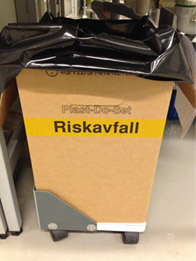
- Boxes must have complete “KTH Albanova Avfallsetikett” (figure 2) labels.
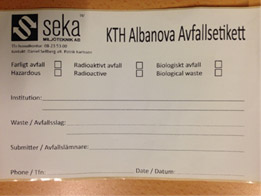
- Do not overfill the box! It should be easy to close the lid.
- A hazardous waste box should be taken care of as soon as it is full or during cleaning days.
- For liquid chemical waste, emptied, cleaned glass bottles or plastic cans (Figure 3.) can be used. Organic, aqueous and allergenic solvents are separated from each other. The bottle/can must be labelled with the “KTH Albanova Avfallsetikett” (figure 2) where content, name and phone number should be clearly stated.
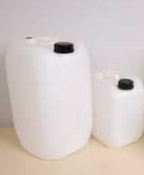
Sharp Objects
Sharp objects are disposed of in designated containers (figure 4). Do not overfill!
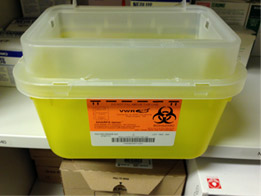
Biological waste
Biological waste is autoclaved and/or killed using Virkon or Jodopax before disposal as non-hazardous waste.
Glass waste
Glass objects are disposed of in containers marked “Glasavfall” (glass waste, figure 5).
Make sure the glass objects are free from hazardous material before disposing them. Do not overfill the box! It should be easy to close the lid.
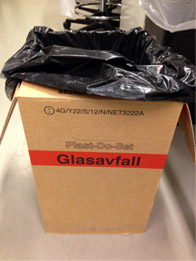
Other waste
For waste categories other than those described above, the one producing the waste is responsible for providing detailed instructions of how to handle the waste and for labeling the waste with a “Hazardous waste label” (figure 2).
How to handle different antibiotics
Different antibiotics should be treated in different ways.
This is a quick guide:
Antibiotic |
What to do? |
|---|---|
Amphotericin = Fungizone |
Autoclave before pouring into sink. |
Ampicillin |
Easily degradable. Can be poured out into the sink. |
Blasticidin |
Unknown effects on environment. Handle as hazardous waste. |
Carbenicillin |
Easily degradable. Can be poured out into the sink. |
Chloramphenicol |
Easily degradable. Can be poured out into the sink. |
Ciprofloxacin |
Not degradable by autoclaving. Handle as hazardous waste. |
Enrofloxacin |
Handle as hazardous waste. |
Erythromycin |
Degradable. Can be poured out into the sink. |
Geneticin (G418) |
Autoclave before pouring into sink. |
Gentamicin |
Autoclave before pouring into sink. |
Kanamycin |
Not easily degradable. Handle as hazardous waste. |
Nalidixic acid |
Handle as hazardous waste. |
Neomycin |
Autoclave before pouring into sink. |
Penicillin |
Easily degradable. Can be poured out into the sink. |
Puromycin |
Autoclave before pouring into sink. |
Streptomycin (including PEST) |
Autoclave before pouring into sink. |
Sulfadoxine |
Autoclave before pouring into sink. |
Tetracycline |
Autoclave before pouring into sink. |
Vancomycin* |
Should only be used when there is no other alternative. If used, handle as hazardous waste. |
Zeocin |
Unknown effects on environment. Handle as hazardous waste. |
Zeomycin |
Unknown effects on environment. Handle as hazardous waste. |
*Vancomycin is the last known antibiotic which MRSA (Staphylococcus) is susceptible to and should be used only when there is no other alternative.
Procedure for antibiotics handled as hazardous waste
Some of the antibiotics cannot be destroyed in-house and therefore have to be treated as hazardous waste.
KTH has an agreement with SEKA, they collect all our hazardous waste. SEKA can help to provide suitable containers for antibiotics if none are available at your division (for example for large volumes of waste containing antibiotics).
Mark the container clearly with its content (use the SEKA label, figure 2) and leave it at “Godsmottagningen” at floor 1 where SEKA will pick it up.
Hazardous waste collection
Hazardous waste is collected by SEKA from the designated room at “Godsmottagningen” floor 1. At pick-up the personnel from SEKA is responsible for writing a Transportdokument”, the personnel at “Godsmottagningen” will sign the document. SEKA sends a copy of the “Transportdokument” to “Godsmottagningen” on arrival at SEKA, that copy will be archived at “Godsmottagningen”.
6. Attachments
No attachments.
8. Amendments
| Approved version | Document date | Amendment | Name |
|---|---|---|---|
| 03 | 2019-04-15 | Routine moved to a new format. Revision of routine due to a new organization of the environmental management system, in which the environmental representatives’ role is replaced by responsible functions. This document replaces MR-CBH-007. | Sara Pettersson |
| 04 | 2021-10-21 | House 10 has been left, which is therefore no longer in the scope. | Åsa Falck |
